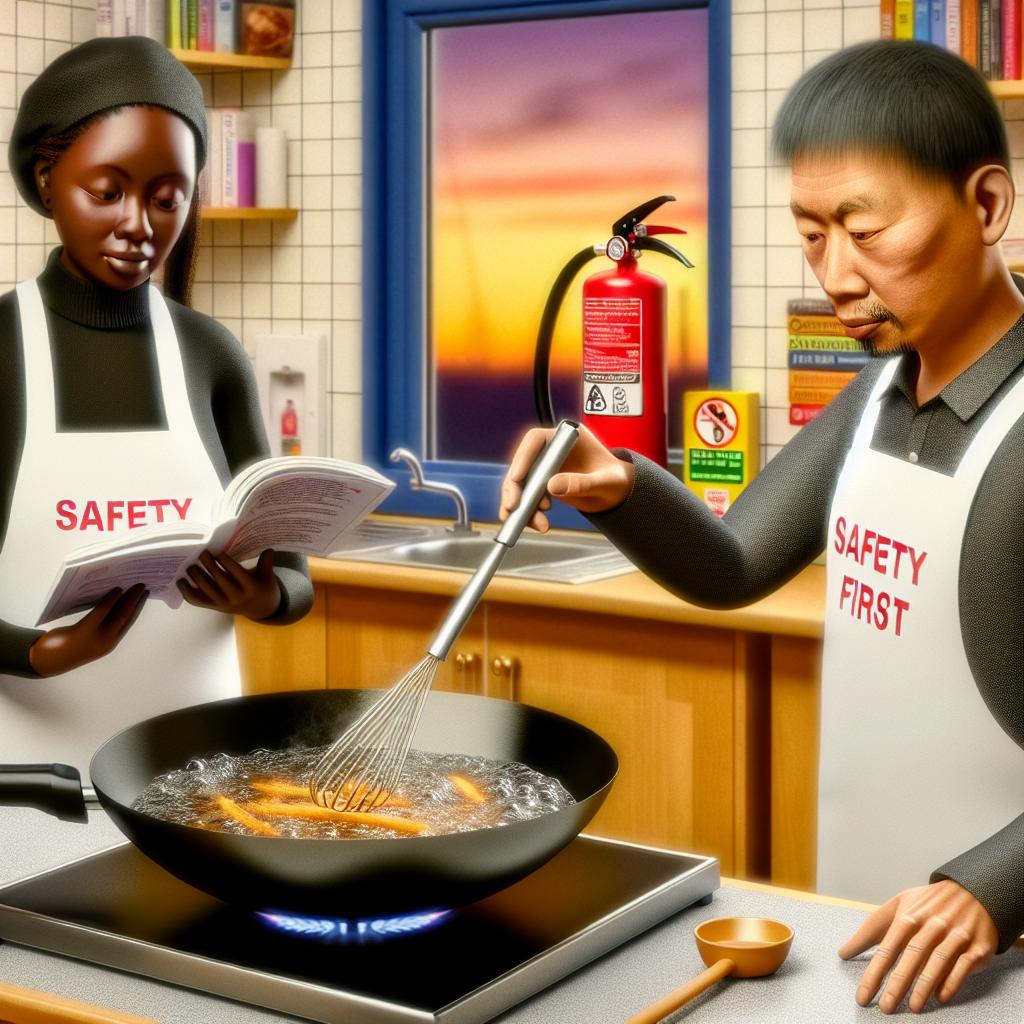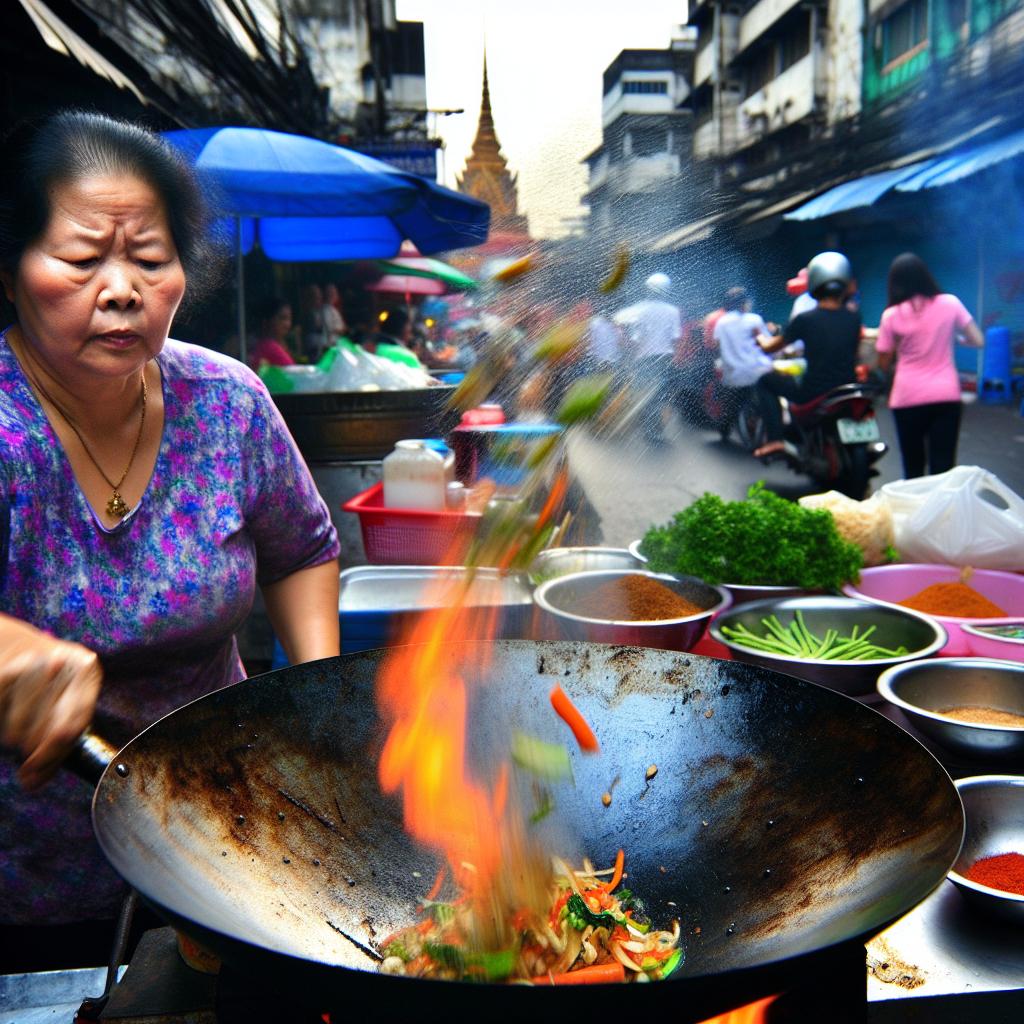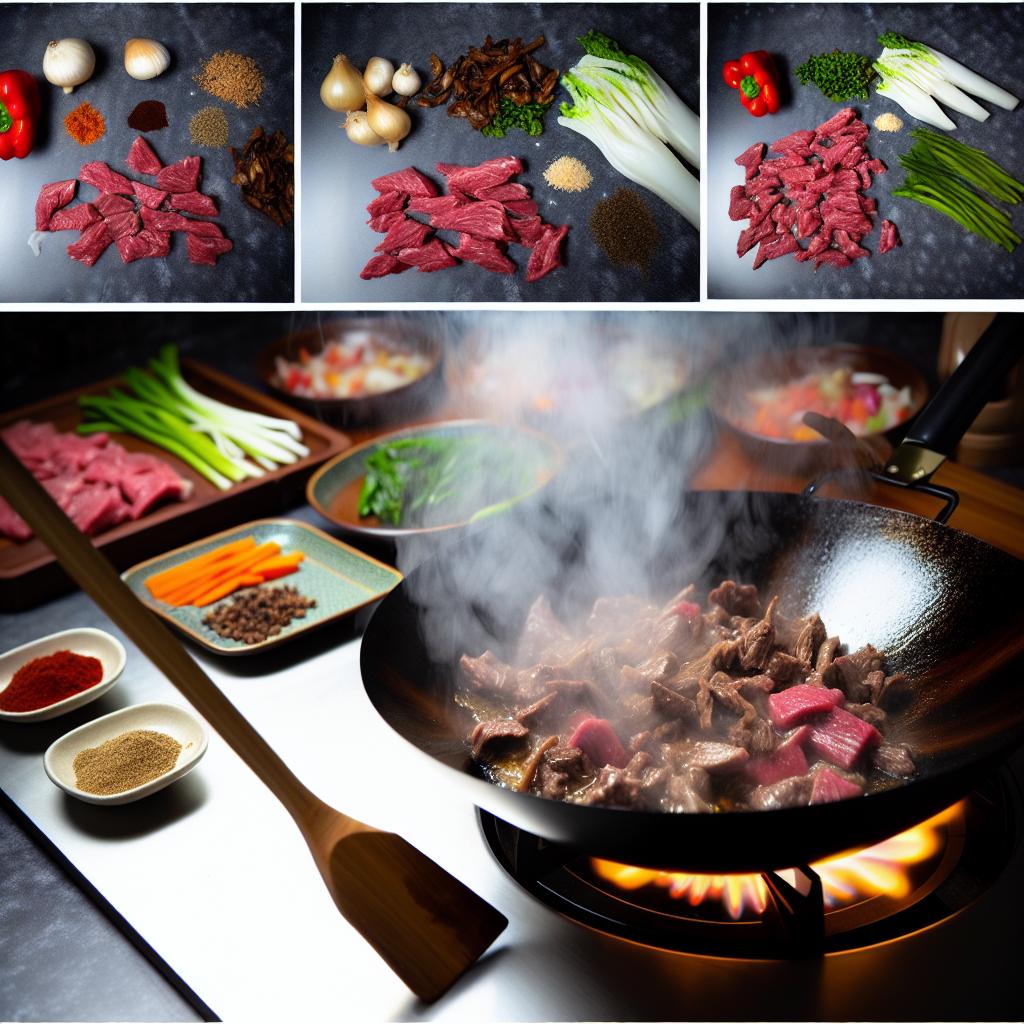Understanding the Basics of Deep-Frying in a Wok
Deep-frying is a widely used cooking technique that involves immersing food in hot oil, allowing it to cook swiftly and evenly. The wok is an exceptional tool for deep-frying due to its unique wide and deep design, which facilitates rapid heating and promotes efficient oil circulation. This article delves into the essentials of deep-frying in a wok, covering everything from equipment and oil selection to practical tips on safety and technique.
The Utility of a Wok in Deep-Frying
The structure of a wok, with its curved bottom and higher walls, makes it ideal for deep-frying. This design allows for a relatively small quantity of oil to submerge the food completely, thus providing an economically efficient way to deep-fry compared to a flat pan. The curved design also prevents oil from splashing out, enhancing safety. When using a wok, make sure to have essential tools like a slotted spoon or skimmer, a reliable thermometer, and a heat-resistant ladle to streamline your cooking process.
Choosing the Right Oil
Oil selection plays a crucial role in achieving successful and safe deep-frying results. Opt for oils with high smoke points, as they perform better under high heat. **Peanut oil**, **canola oil**, and **safflower oil** are commonly recommended choices because they withstand high temperatures without breaking down. Using oils with high smoke points reduces the risk of generating smoke, which can impact flavor and safety.
Preparing Your Work Area
An organized and safe work area is essential for deep-frying. Make sure to place your wok on a stable cooking surface and eliminate any flammable materials nearby. Having your ingredients ready before heating the oil minimizes the time the oil remains hot, thereby preventing deterioration and other risks associated with extended heating.
Measuring and Heating the Oil
Pour the chosen oil into the **wok**, ensuring it’s deep enough to immerse your food entirely while leaving enough space to prevent overflow. Utilizing a thermometer is critical to achieving the required oil temperature, typically between **350°F to 375°F**, as this ensures optimal cooking results. Oil at the correct temperature cooks food quickly and seals in flavor while preventing excess oil absorption.
Handling the Food
When the oil reaches the desired temperature, carefully lower the food into the hot oil using a **slotted spoon** or **heat-resistant ladle**. It’s important not to overcrowd the wok since this can lower the oil temperature and result in uneven cooking. To maintain quality, consider frying in batches as required.
Monitoring the Cooking Process
Consistent monitoring of the oil temperature ensures that your food cooks under ideal conditions. Adjust the stove’s heat settings as needed to maintain the oil temperature. Use your slotted spoon or skimmer to gently turn or remove food pieces when they reach the desired level of cooking. This tool allows you to drain excess oil back into the wok, reducing waste.
Final Steps: Removing and Draining the Food
After achieving a golden brown finish, use the skimmer or spoon to remove the food from the oil. Transfer the cooked food to a plate lined with **paper towels** to soak up any remaining oil. This step is crucial for maintaining crispiness and balancing richness.
Post-Cooking Safety and Clean-Up
Proper handling post-cooking is crucial for both safety and cleanup. Allow the oil to cool before moving or disposing of it. Depending on your local regulations, follow appropriate procedures for storing or discarding used oil. Once cooled, clean the wok with hot, soapy water to remove oil residues, preparing it for future cooking endeavors.
Additional Tips for Safe Frying
Safety should always be a priority when deep-frying. Monitor the wok and oil consistently, ensuring you have a thermometer to verify accurate cooking temperatures. Never leave the wok unattended while it’s in use, and ensure that a fire extinguisher suitable for oil fires is accessible as a precautionary measure.
If you aspire to refine your deep-frying skills or experiment with new recipes, various culinary resources and expert guides offer valuable insights and detailed techniques. Engaging with such materials can broaden your culinary repertoire and enhance safety awareness, making your deep-frying endeavors both enjoyable and successful.
The Wok: A Vital Tool in Thai Cuisine
The wok is an indispensable tool in many Asian kitchens, particularly in Thai cuisine. Known for its versatility and unique design, it allows various cooking techniques essential in crafting traditional Thai dishes. This article explores the significance of the wok in Thai cooking, its characteristics, and its role in preparing iconic dishes.
Characteristics of a Wok
A wok is a prominent feature in Asian cooking due to its distinctive round-bottomed shape, which ensures even heat distribution across its surface. This feature is crucial for achieving the desired cooking results. Traditionally constructed from carbon steel or cast iron, the wok is available in a variety of sizes, each with sloping sides that enable optimal stir-frying. The simplicity and effectiveness of a wok’s design have significantly contributed to its widespread adoption across various Asian culinary traditions.
The Unique Design
The design of the wok, characterized by its round bottom and high sides, stands out from regular pans and pots because of its ability to distribute heat consistently and maintain high temperatures. This unique form is particularly well-suited for high-temperature cooking methods that are staples in Thai cuisine, such as stir-frying and deep-frying. The sloping sides of a wok allow for ease in tossing and turning ingredients, crucial for ensuring that the heat reaches every part of the food being cooked and maintains the needed texture.
Materials Used
Carbon steel is the material of choice for many traditional woks due to its excellent heat retention and non-stick properties once properly seasoned. Cast iron, although heavier, is another favored material because of its durability and heat retention capabilities. Both materials contribute to the wok’s efficiency and adaptability in the kitchen. These characteristics are esteemed in Thai cooking, where precision in temperature and timing greatly influences the final taste and texture of a dish.
Benefits of Using a Wok
The wok is celebrated for its versatility. Its design isn’t only used for stir-frying but also allows for deep-frying, steaming, boiling, braising, and even smoking food. This multifunctional capability is especially valuable in Thai cuisine, where diverse cooking methods come into play. The wok’s ability to quickly reach and maintain high temperatures contributes to preserving the texture and nutritional content of ingredients, which is a crucial aspect of Thai cooking.
High-Temperature Cooking
One of the primary benefits of using a wok is its ability to offer efficient high-temperature cooking. This capacity is vital in stir-frying, where ingredients must cook quickly to preserve their natural flavors and textures. Additionally, quick cooking at high temperatures minimizes nutrient loss, ensuring that the nutritional profile of vegetables and meats is maintained, an essential aspect of healthy eating practices observed in Thai cuisine.
Even Heat Distribution
The wok’s design promotes even heat distribution, which is crucial for cooking dishes evenly. This characteristic is particularly fundamental when frying or boiling, where equal heat exposure ensures that ingredients cook uniformly, avoiding overcooked or undercooked sections. This even heat is particularly beneficial for dishes that require meticulous attention to detail, such as those involving tender cuts of meat or delicately flavored sauces.
The Wok in Thai Cooking Techniques
Thai cuisine is renowned for its intricate balance of flavors, and the wok plays a pivotal role in achieving this complexity. Below, we explore some common Thai cooking techniques that rely heavily on the wok:
Stir-Frying
Stir-frying is perhaps the most popular technique associated with the wok. By cooking at high temperatures with constant stirring, this method keeps vegetables crisp and meats tender. Dishes like Pad Thai and Pad Kee Mao (Drunken Noodles) are traditional stir-fried meals that owe their texture and flavor to the wok’s high-heat capabilities. In these dishes, rapid frying at elevated temperatures ensures that the natural flavors of the ingredients are locked in, resulting in a harmonious balance of taste and texture.
Deep-Frying
The wok’s deep structure makes it ideal for deep-frying, a method frequently employed in Thai cooking to achieve delightfully crispy dishes. Delicacies such as spring rolls and fried fish are efficiently prepared using this technique, which quickly seals in flavors due to the oil’s high temperature. The speed and intensity of deep-frying in a wok create a wonderfully textured and flavor-packed exterior while preserving a moist and tender interior.
Braising and Steaming
Beyond frying, the wok is also indispensably used for braising and steaming. Dishes like green curry often require a gentle simmering process in the wok, enabling the intricate flavors to meld together beautifully. Its dome-like structure can accommodate a bamboo steamer basket perfectly, making it highly efficient for preparing steamed dishes that demand delicate treatment and precise cooking temperatures.
Maintenance of a Wok
To ensure its longevity and performance, a wok requires meticulous care. Regular seasoning is essential for maintaining its non-stick surface, especially for carbon steel models. After each use, cleaning the wok with warm water and a soft sponge, then thoroughly drying it, preserves its integrity and prevents rust. Understanding the maintenance requirements of a wok ensures its adequacy in delivering consistently excellent cooking results.
Seasoning a Wok
Seasoning involves coating the wok with a thin layer of oil and heating it to a high temperature. This process creates a natural non-stick layer, enhancing the wok’s cooking performance and preventing food from sticking during future use. The seasoning process not only aids in cooking but also protects the wok from rusting, contributing to its durability and effectiveness as a cooking implement.
Conclusion
The wok is more than just a cooking tool in Thai cuisine; it is an integral component that facilitates the creation of authentic flavors and textures. Its ability to accommodate a range of cooking methods makes it invaluable in a Thai kitchen. Understanding and appreciating the role of the wok gives deeper insight into the rich culinary traditions of Thailand. For more insight into Thai cooking techniques, visit Thai Food Online.
Introduction
Cooking meat in a wok offers not just efficiency but also the enhancement of flavors, making it a favored method for many. The unique design of the wok, coupled with high heat, ensures that the meat is cooked evenly while preserving its natural juices and flavors. The blend of science and art in wok cooking can elevate your culinary skills, resulting in a delicious meal. This article will delve into the various techniques and factors that contribute to maximizing flavor when cooking meat using a wok.
The Benefits of Using a Wok
The design of a wok is specifically tailored for high-temperature cooking. It provides advantages that are not easily replicated by other cooking utensils. The most notable feature is the sloped sides, which facilitate quick stirring and flipping of ingredients. This prevents food from sticking, a common issue in traditional flat-bottomed pans. Cooking with a wok promotes even heat distribution, which is essential for ensuring that every piece of meat is cooked uniformly.
Additionally, the wok’s ability to deliver a distinct smokey flavor is unmatched, and it is this characteristic flavor that many associate with authentic stir-fries. The high-heat environment of the wok allows for the development of complex flavors that enrich the overall taste of the dish.
Choosing the Right Meat
Selecting the appropriate meat is fundamental in wok cooking. The ideal cuts of meat should be those that can withstand high heat and cook quickly. Understanding the nature of different meat cuts helps in making informed choices.
Thin cuts are particularly well-suited for wok cooking. Meat such as beef strips, chicken slices, and pork loin are preferred due to their relatively low fat content and tender texture. They respond well to quick cooking, ensuring that they remain tender and flavorful.
Size consistency is also critical in ensuring that the meat cooks evenly. Cutting the meat into uniform pieces prevents some pieces from being overcooked while others are left underdone. Although a slightly thicker piece may add a bit more cook time, it also provides some tolerance against overcooking, which can make the meat tough.
Preparation Techniques
Success in wok cooking is significantly influenced by how well the meat is prepared before it even touches the heat. A few essential techniques can significantly impact the outcome.
Marination: Allowing the meat to soak in a well-crafted marinade can impart additional flavors and help tenderize the meat. A classic marinade might include ingredients such as soy sauce, ginger, garlic, and a hint of oil. These components not only enhance the flavor but also break down the protein structure, leading to a more tender bite. A minimum marination time of 20 minutes is recommended to allow the flavors to penetrate the meat.
Drying the meat: For optimal browning, it is crucial to remove excess moisture. Pat the meat dry using paper towels before adding it to the hot wok. This step is vital because moisture can cause the meat to steam rather than sear, impeding the development of the desired crust.
Cooking Process
Heat Management
One of the first steps in cooking with a wok is appropriately managing heat. Preheating the wok until it is almost smoking ensures that the temperature is high enough to sear the meat effectively. This high-heat environment facilitates the Maillard reaction—a chemical process responsible for browning—which contributes to the depth of flavor in cooked meats.
Oil Selection
Choosing the right type of oil is crucial for wok cooking. Oils with a *high smoke point*, such as peanut or vegetable oil, are ideal. These oils can withstand the intense heat without breaking down, ensuring that the meat’s natural flavors are not overshadowed by burnt oil residues.
Stir-Frying Technique
Once the wok is properly preheated, add a small amount of oil and rotate the wok to coat it evenly. Quickly introduce the prepared meat, arranging it in a single layer. This maximizes contact with the hot surface, facilitating a swift sear. Use a metal spatula or a wok spoon to continuously toss the meat. This technique prevents it from adhering to the wok and ensures even cooking, which is essential for achieving a consistent texture and taste. As the meat transforms, it will take on a brown hue and develop a crispy crust that holds in the juices.
Additional Flavor Enhancements
To add layers of flavor, incorporate aromatics toward the tail end of the cooking process. Ingredients such as garlic, ginger, and onions are excellent choices. Adding them later prevents them from burning, thus ensuring that their essential oils and flavors are released without the bitter taste that results from overcooking. These aromatics elevate the overall flavor profile of the dish, enhancing the inherent tastiness of the meat.
Serving Suggestions
Once the meat reaches your desired level of doneness, remove it from the wok and allow it to rest briefly. This resting period enables the juices to redistribute throughout the meat, resulting in a juicier and more flavorful bite. For a complete meal, pair the seared meat with stir-fried vegetables, rice, or noodles. This approach creates a balanced dish, offering a satisfying combination of proteins, carbohydrates, and fibers.
Conclusion
Cooking meat in a wok is an art form that, when executed properly, transforms basic ingredients into a dish rich with flavor and texture. Wok cooking is not just about the ingredients; it’s a technique that, with proper execution, unlocks complex flavors making every bite memorable. By choosing the right meat, utilizing effective preparation techniques, and employing proper cooking processes, you can achieve restaurant-quality results in your own kitchen. For those interested in exploring further, numerous culinary resources and expert blogs can provide additional insights and recipes to elevate your wok cooking experience to new heights.


